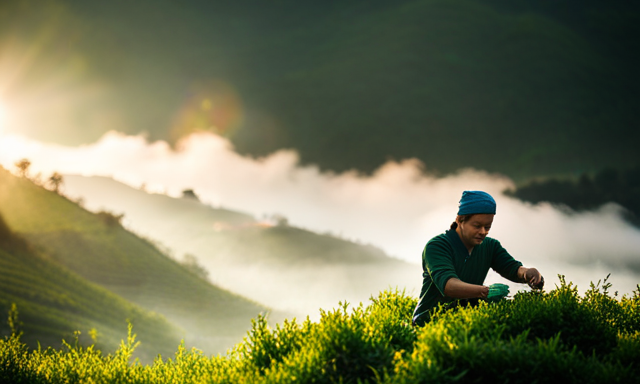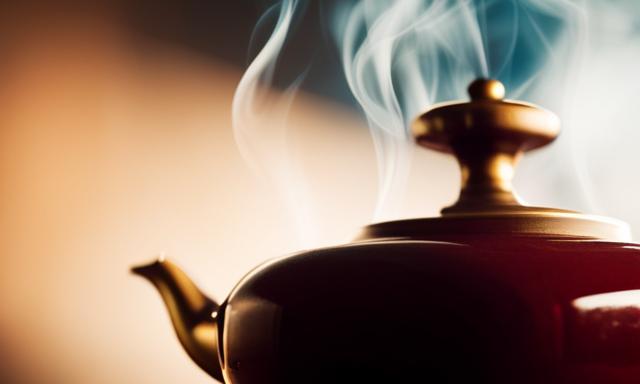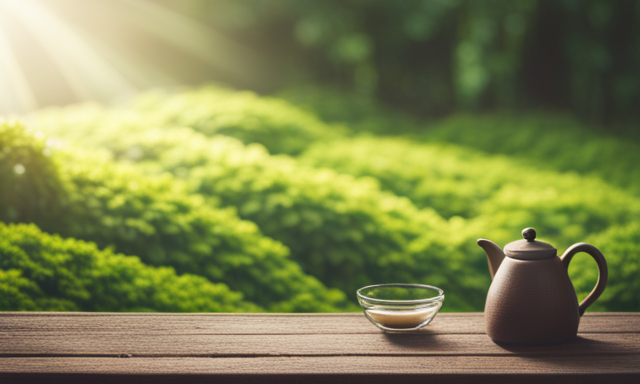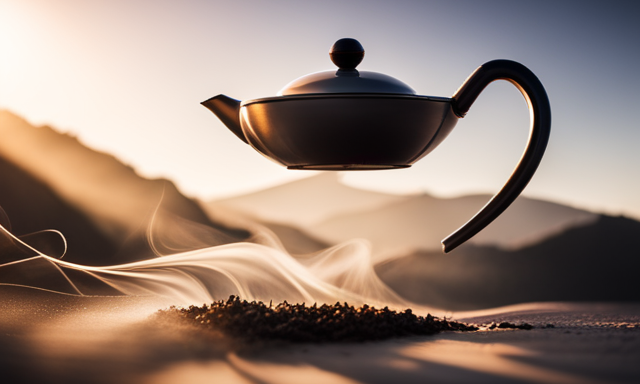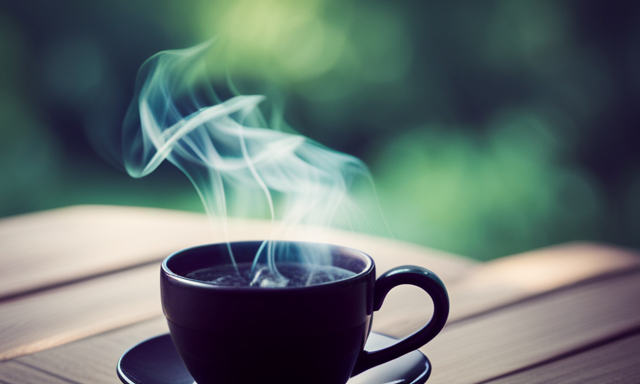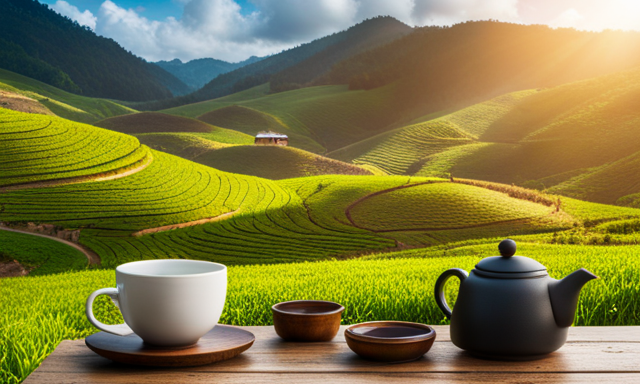Have you ever been curious about how a plain tea leaf can evolve into a rich and fragrant drink? Let me guide you through the intriguing journey of creating oolong tea.
Like a master craftsman shaping a delicate piece of art, oolong tea undergoes a meticulous series of steps, each contributing to its unique flavor and character.
First, the tea leaves are plucked, carefully selecting only the finest and most tender leaves. Then, they are withered and dried, allowing them to lose their moisture and prepare for the next stage.
Next, the leaves are skillfully rolled, releasing their natural oils and flavors. This is followed by the oxidation process, where the leaves are left to react with the air, creating the distinct taste oolong tea is known for.
To further enhance its flavors, the leaves are fired or roasted, adding depth and complexity to the final product. Finally, the tea is packaged and stored, ensuring its freshness for you to enjoy.
In the upcoming article, we will delve deeper into each step, explore popular varieties, and discover the numerous health benefits of this remarkable beverage.
So, grab a cup of oolong tea and join me on this delightful journey of craftsmanship and flavor.
Key Takeaways
- The production process of oolong tea involves selecting the finest and tender tea leaves, handpicking the bud and first two leaves, sorting and removing impurities, withering and drying the leaves, rolling them to enhance flavors and aromas, and determining the type and flavor profile through oxidation.
- Oolong tea offers numerous health benefits when consumed, and proper packaging and storage in airtight containers are crucial for preserving its freshness.
- Different storage methods, such as vacuum-sealed bags, tin containers, ceramic jars, and glass jars with airtight seals, can be used to protect oolong tea from oxidation, light, moisture, and maintain its delicate flavor and aroma.
- Brewing oolong tea requires finesse and attention to detail, and various techniques can be employed to enhance its flavor and aroma.
The Plucking of Tea Leaves
Now, let’s dive into how you pluck those delicate tea leaves to create the perfect oolong blend.
Tea leaf harvesting is a crucial step in the process of making oolong tea. It requires precision and expertise to ensure only the finest leaves are selected. Skilled tea pluckers carefully handpick the tea leaves, usually opting for the bud and first two leaves on the stem. This careful selection guarantees the highest quality and flavor.
Once the leaves are harvested, they undergo tea leaf processing. This involves sorting and removing any unwanted impurities, such as stems or damaged leaves.
The plucked tea leaves are then ready for the next stage of the oolong tea production process: withering and drying. This ensures the leaves maintain their natural aroma and flavor.
Withering and Drying the Leaves
During the withering and drying process, the fragrant leaves transform, releasing their natural flavors and aromas. This crucial step in oolong tea production requires careful attention to withering techniques and drying methods. Withering involves spreading the freshly plucked leaves in a well-ventilated area, allowing them to wilt and lose moisture. This can be done indoors or outdoors, depending on the weather conditions and desired flavor profile. Once withered, the leaves are then gently dried to halt oxidation and preserve their delicate flavors. Common drying methods include sun drying, oven drying, and air drying. Each method imparts its own unique characteristics to the tea. The right combination of withering and drying techniques is essential to achieve the desired taste and aroma in oolong tea. This process sets the stage for the next step – rolling the leaves, which further enhances the tea’s flavors and aromas.
Rolling the Leaves
Once the leaves have been withered and dried, they’re ready for the next crucial step in the process – rolling, which enhances the flavors and aromas of the tea. Leaf rolling techniques play a vital role in shaping the tea leaves into their distinctive form. This step requires expertise and precision to achieve the desired outcome.
Here are some key aspects of leaf rolling:
-
Hand rolling: Skilled artisans gently roll the leaves by hand, applying just the right amount of pressure to shape them without breaking.
-
Machine rolling: In modern tea production, machines are used to roll the leaves, ensuring consistency and efficiency.
-
Leaf oxidation: During the rolling process, the leaves are partially oxidized, which contributes to the unique flavor profile of oolong tea.
-
Leaf shaping: Rolling helps create the tightly curled appearance of oolong leaves, which allows for a gradual release of flavor during steeping.
-
Aromatization: Rolling releases essential oils stored in the leaves, enhancing the tea’s aroma and creating a more robust flavor profile.
As the rolling process concludes, the tea leaves are now prepared for the subsequent section – the oxidation process.
Oxidation Process
After the rolling process, a magical transformation takes place as the tea leaves undergo a captivating oxidation process. This step is crucial in determining the type and flavor profile of the oolong tea. There are three main types of tea oxidation: light, medium, and dark. Light oxidation results in a delicate and floral taste, while medium oxidation produces a more balanced flavor with hints of fruit and honey. Dark oxidation, on the other hand, yields a rich and robust taste with notes of caramel and chocolate. The benefits of drinking oxidized tea are numerous. It helps in digestion, promotes heart health, boosts metabolism, and strengthens the immune system. As the leaves are oxidized, they acquire distinct flavors and aromas that make each type of oolong tea unique. Moving on to the next step, firing or roasting the leaves enhances their flavors even further.
Firing or Roasting the Leaves
To truly enhance the flavors and aromas of your oolong tea, you must delve into the art of firing or roasting the leaves. Firing techniques play a crucial role in the flavor development of oolong tea. The leaves are carefully exposed to a controlled heat source, which removes any residual moisture and stops the oxidation process. This step is essential to ensure the tea leaves retain their unique characteristics and flavors.
The firing process can vary depending on the desired outcome, with some teas being lightly roasted for a delicate taste, while others are heavily fired for a robust flavor profile. The firing also imparts a distinct smoky and toasty aroma to the tea.
As we move on to the next step of sorting and grading the tea, the firing process sets the foundation for the quality and taste of the final product.
Sorting and Grading the Tea
The process of sorting and grading the tea involves carefully categorizing and classifying the leaves based on their quality and characteristics. Grading and quality control are crucial steps in ensuring that only the finest leaves make it into the final product.
Tea experts use their knowledge and expertise to meticulously evaluate the leaves through a process called tea tasting. This evaluation involves carefully examining the appearance, aroma, and taste of the tea. Each batch is graded based on factors such as leaf size, color, and aroma intensity.
The grading system helps to maintain consistency and allows consumers to choose their preferred flavor profiles. Once the leaves have been sorted and graded, they are ready for the next stage of the process: packaging and storage.
Packaging and Storage
When packaging and storing your tea, you’ll want to ensure that it’s carefully sealed in airtight containers to preserve its freshness and flavor.
Here are four key techniques to ensure that your oolong tea stays at its best:
-
Vacuum-sealed bags: This packaging method removes all air from the bag, preventing oxidation and maintaining the tea’s aroma.
-
Tin containers: These sturdy and opaque containers protect the tea from light and moisture, keeping it fresh for longer periods.
-
Ceramic jars: These containers offer excellent insulation and are ideal for storing oolong tea, as they help maintain its delicate flavor and aroma.
-
Glass jars with airtight seals: These transparent containers allow you to admire the tea leaves while still providing airtight protection.
Proper storage methods are crucial to maintaining the quality of your oolong tea.
Now, let’s move on to the next section about brewing and serving oolong tea.
Brewing and Serving Oolong Tea
Get ready to experience the rich and nuanced flavors of your freshly brewed oolong tea as you embark on the art of serving this exquisite beverage.
Brewing oolong tea requires finesse and attention to detail. There are various brewing techniques that can enhance the flavor and aroma of the tea. One popular method is the Gongfu style, which involves using a small teapot to brew multiple, short infusions. This method allows you to savor the evolving flavors of the tea with each steep.
Another option is the traditional Chinese tea ceremony, which emphasizes the ritualistic aspects of tea preparation and serving. It involves precise movements and specific utensils to create an immersive and meditative experience.
As you delve into the world of oolong tea, understanding these brewing techniques and tea ceremonies will deepen your appreciation for this remarkable beverage.
Transitioning to the subsequent section about popular varieties of oolong tea, let’s explore the diverse range of flavors and aromas that await you.
Popular Varieties of Oolong Tea
After learning about the brewing and serving of oolong tea, let’s now explore the popular varieties of this delightful beverage. Oolong tea comes in a wide range of flavors and aromas, each with its unique characteristics. From floral and fruity to toasty and nutty, there is a flavor profile to suit every palate. Some popular varieties include Tie Guan Yin, known for its orchid-like aroma, and Da Hong Pao, which offers a rich and roasted taste. Each variety requires different brewing techniques to bring out its best flavors. Some may be steeped at a lower temperature for a shorter time, while others benefit from a longer infusion. As we delve into the health benefits of oolong tea, we’ll discover how these flavors and brewing techniques contribute to its overall wellness properties.
Health Benefits of Oolong Tea
Indulge in the numerous health benefits of oolong tea, as it promotes overall wellness and vitality for your body and mind. Oolong tea is known for its ability to aid in weight loss. It contains polyphenols, which help increase metabolism and fat oxidation. These compounds also help regulate blood sugar levels, preventing spikes and crashes that can lead to cravings and overeating.
Oolong tea is also rich in antioxidants, which protect the body against free radicals and reduce the risk of chronic diseases, such as heart disease and cancer. Additionally, oolong tea provides a gentle energy boost without the jitters often associated with coffee. Its calming properties can also help reduce stress and anxiety.
Incorporating oolong tea into your daily routine can be a simple and enjoyable way to support your overall health.
Frequently Asked Questions
How long does it take for oolong tea leaves to wither and dry?
The withering process for oolong tea leaves typically takes around 8-12 hours, depending on factors like humidity and leaf thickness. After withering, the leaves are then dried for about 4-6 hours until they reach the desired moisture level.
Can oolong tea be brewed using a regular tea bag?
Brewing oolong tea with a regular tea bag is like settling for a photocopy when you can have the original masterpiece. Loose leaf oolong tea offers better flavor and aroma, ensuring a higher quality brew.
Are there any specific temperature requirements for brewing oolong tea?
Temperature requirements for brewing oolong tea vary depending on the specific type. Generally, a water temperature of 190-200°F (88-93°C) is recommended. Steeping time ranges from 1-5 minutes, ensuring a balanced flavor profile.
What is the ideal steeping time for oolong tea to achieve the best flavor?
The ideal steeping time for oolong tea to achieve the best flavor is around 3-5 minutes. To enhance the flavor, you can try flavor enhancement techniques like steeping multiple times or adjusting the water temperature.
Can oolong tea be aged like other types of tea?
Absolutely! Oolong tea can be aged just like other types of tea. Aging enhances its flavor, deepens the aroma, and smoothens the taste. The benefits of aging oolong tea are truly remarkable.
Conclusion
And there you have it, the intricate process of making oolong tea unfolds before our eyes. It’s fascinating how something as simple as plucking leaves can lead to a beverage that is steeped in flavor and tradition.
From withering and drying to rolling and oxidizing, each step contributes to the unique taste and aroma that oolong tea is known for. And let’s not forget the firing and packaging processes, which ensure that every sip is a delightful experience.
So, next time you sip on that cup of oolong tea, remember the craftsmanship and care that went into creating it. Cheers to the art of tea-making!

